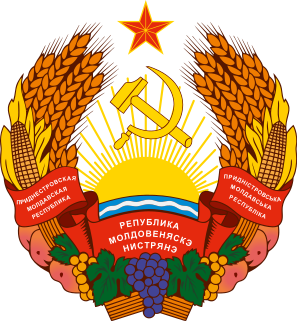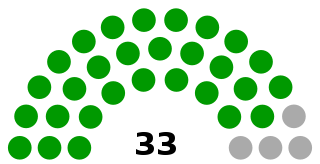 W
WPolitics of Transnistria, a de facto independent state situated de jure within the Republic of Moldova in Eastern Europe, takes place in a framework of a semi-presidential republic, whereby the President of Transnistria is head of state and the Prime Minister of Transnistria is head of government. Executive power is exercised by the government. Legislative power is vested in both the government and parliament. Formally, Transnistria has a multi-party system and a unicameral parliament, called the Supreme Council. The president is elected by popular vote. The latest parliamentary elections were held in December 2010; however, they were not monitored by international organizations such as Organization for Security and Co-operation in Europe (OSCE), which has expressed doubts about the level of democracy in the region, and were not recognized by other countries.
 W
WThe involvement of the Soviet 14th Guards Army in the War of Transnistria was extensive and contributed to the outcome, which left the Pridnestrovian Moldavian Republic (PMR) with de facto independence from the Republic of Moldova.
 W
WThe Anthem of Transnistria, titled We chant thy praises of Pridnestrovia, was written by Boris Parmenov, Nicholas Bozhko and Vitaly Pishenko, and composed by Boris Alexandrovich Alexandrov. The anthem has lyrics in all three official languages of Transnistria: Romanian, Russian, and Ukrainian. They are, however, not all literal translations of one another. The origin of the anthem was from the Russian patriotic song Long Live our State, a 1943 composition that was one of the proposed songs to be the anthem of the former Soviet Union. Boris Alexandrov's composition was, however, rejected in favor of the one submitted by his father, Alexander Alexandrov.
 W
WThe coat of arms of Tiraspol, capital of Transnistria, is a shield depicting the Dniester River with stylized grapes on one side, and the symbol of industry on another.
 W
WThe coat of arms of Transnistria constitutes a remodeled version of the former Moldavian Soviet Socialist Republic emblem, as substituted by the internationally recognized Moldovan government after the dissolution of the Soviet Union in 1991. The only major pictorial change made in the Transnistrian version involves the addition of waves, representing the River Dniester. However, the inscriptions on the banner were changed: unlike the Moldavian SSR emblem, which bore the acronym РССМ and the USSR state slogan "Workers of the world, unite!" in the Russian and Moldavian languages, the Transnistrian emblem bears the name Pridnestrovian Moldavian Republic in the Romanian, Russian and Ukrainian languages. In the Moldovan Cyrillic version of Romanian, it reads "Република Молдовеняскэ Нистрянэ" ; in Russian, it reads "Приднестровская Молдавская Республика" ; and, in Ukrainian, it reads "Придністровська Молдавська Республіка". Despite the emblem's depiction of the hammer and sickle, Transnistria is not a socialist state.
 W
WThe current Constitution of Transnistria was approved by national referendum on 24 December 1995, and signed into law by the President of Transnistria on 17 January 1996. As part of the territory's move towards market based reforms, it was modified on 30 June 2000.
 W
WThe flag of the Pridnestrovian Moldavian Republic consists of three horizontal bands of red, green and red, of vertical width 3:2:3, with the golden hammer and sickle and a gold-bordered red star in the upper canton. Transnistria adopted this design that comprises a version of the 1952–1990 flag of the Moldavian Soviet Socialist Republic in the 2000 Law about State Symbols.
 W
WThe Government of Pridnestrovian Moldavian Republic is the political leadership of the unrecognized, but de facto independent, Pridnestrovian Moldavian Republic, better known in English as Transnistria.
 W
WThe state of affairs with human rights in Transnistria has been criticized by several governments and international organizations. The Republic of Moldova, and other states and non-governmental organizations (NGOs) claim that the government of Transnistria is authoritarian and has a record of arbitrary arrest and torture.
 W
WInternational recognition of Transnistria – a disputed region in Eastern Europe located between Moldova and Ukraine – is controversial. Although Transnistria declared independence in 1990, no United Nations member recognises its sovereignty and the region is considered by the UN to be part of Moldova. As of 2011, only Abkhazia, the Republic of Artsakh and South Ossetia recognise its independence, all themselves states with limited recognition. Despite not officially recognizing Transnistria's independence, Russia has established a consulate in the disputed territory.
 W
WLesbian, gay, bisexuals, and transgender persons in Transnistria may face legal challenges not experienced by non-LGBT residents. The Pridnestrovian Moldavian Republic (PMR) is an unrecognised breakaway state with its own judicial system. For the legal situation for LGBT individuals in Moldova, which Transnistria is recognised by most states as belonging to, see LGBT rights in Moldova.
 W
WThe Ministry of State Security is the Transnistrian state security service.
 W
WMoldova–Transnistria relations are the political and economic relations between the Republic of Moldova and Transnistria, an unrecognized state between the Dniester River and Ukraine. During the dissolution of the Soviet Union, political tensions in the Moldavian Soviet Socialist Republic led to Transnistria declaring independence from Moldova, culminating in the Transnistrian War of 1992. As part of the ceasefire agreement ending the war, a Joint Control Commission composed of Moldovan, Transnistrian, and Russian forces was established to supervise the demilitarized zone which was located in the Transnistrian region. The Joint Control Commission still supervises the zone, and negotiations to resolve the dispute are ongoing. The negotiations are supported by the Russian Federation, Ukraine, the United States, the European Union, and the Organization for Security and Co-operation in Europe (OSCE).
 W
WThe Moldovan Cyrillic alphabet is a Cyrillic alphabet designed for the Romanian language spoken in the Soviet Union (Moldovan) and was in official use from 1924 to 1932 and 1938 to 1989.
 W
WAlthough most commonly known in English as Transnistria, the official name of the region is Pridnestrovie. Here is a detailed explanation of the names used for Transnistria, both official and unofficial, as they appear in the local languages and in English.
 W
WThe Supreme Council of the Pridnestrovian Moldavian Republic is the parliament of Transnistria. The unicameral legislature consists of 43 seats, all of which are determined by single mandate constituencies. It is headed by a chairman.
 W
WThe political status of Transnistria, a self-proclaimed state on the internationally recognized territory of Moldova, has been disputed since the Transnistrian declaration of independence on 2 September 1990. This declaration sought to establish a Soviet Socialist Republic that would be independent from local Moldovan authority. Following the breakup of the Soviet Union and Moldova's own declaration of independence in 1991, the Pridnestrovian Moldavian Soviet Socialist Republic (PMSSR) was transformed into the Pridnestrovian Moldavian Republic (PMR). However no United Nations member country recognizes the PMR's independence.
 W
WThis is a list of foreign ministers of Transnistria.2000–2008: Valeriy Litskai 2008–2012: Vladimir Yastrebchak 2012–2015: Nina Shtanski 2015–present: Vitaly Ignatyev
 W
WPublic holidays in Transnistria lists the official public holidays recognized by the breakaway Transnistrian government. On these days, government offices, offices of foreign missions and some shops, are closed. If the date of observance falls on a Saturday or Sunday, the following Monday will be a day off in lieu of the holiday.
 W
WThe Republic Day of Transnistria also known in the West as Independence Day or National Day is the main state holiday in the partially recognized republic of Transnistria. This date is celebrated annually on September 2.
 W
WȘtefan Urâtu is a politician from Moldova.
 W
WThe Vice President of Transnistria was a political position in that unrecognized state. He/she was the deputy head of state.